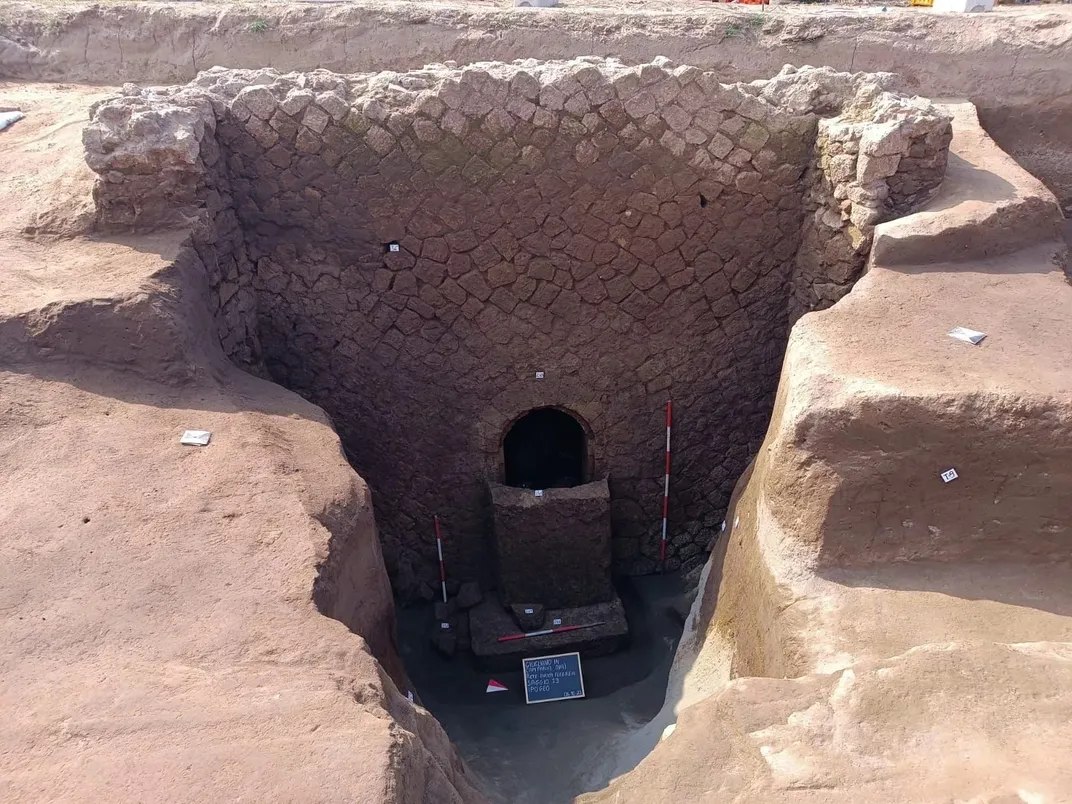
Th12
An extraordinary archaeological discovery has brought to light a hidden Roman tomb, providing an unprecedented glimpse into the wealth and beliefs of the Roman Empire. Unearthed during the installation of a water pipeline in Giugliano, near northern Naples, this remarkable find offers valuable insights into the funerary practices and religious symbolism of the time. The discovery consists of a well-preserved underground funerary chamber, offering a rare look into the lavish burial customs of Roman society during the early imperial period.
A Surprising Discovery
The excavation began with a modest find: several tombs dating back to the early imperial era. These graves, although modest in appearance, were well-preserved and sparked initial interest among archaeologists. However, further digging revealed something far more extraordinary—a richly decorated funerary chamber measuring 3 by 4 meters, lying more than 3 meters below the surface. Sealed for over 2,000 years, the chamber was found to be remarkably intact, with vivid frescoes adorning its walls, offering a rare and unparalleled glimpse into Roman artistic practices.

An Intricate Underworld
Inside the chamber, archaeologists uncovered two sarcophagi containing the skeletal remains of the deceased, along with their accompanying funerary objects. The walls of the chamber were intricately decorated with garlands and festoons, which were commonly used in Roman funeral rites to symbolize mourning and reverence for the deceased. The frescoes themselves were a breathtaking sight, with one wall depicting two ichthyocentaurs—mythical creatures that were part human, part horse, and part fish—gripping a shield, possibly referencing Rome’s naval victories and the nearby establishment of the maritime colony of Liternum.

The opposite wall presented a more poignant theme: the underworld. Cerberus, the three-headed dog who guarded the gates of Hades, was depicted engaged in a fierce battle with Heracles, one of the greatest heroes of Roman mythology. This scene was enhanced by the presence of Mercury, the messenger god, symbolizing divine intervention and the connection between the mortal world and the realm of the gods. This powerful imagery suggests a strong belief in the afterlife, where heroes like Heracles were honored, and divine figures like Mercury played a crucial role in guiding souls.
Historical Context and the Tomb’s Owner
The dating of the tomb is relatively precise, ranging from the founding of the nearby Liternum colony in 194 BC to AD 27. An inscription inside one of the tombs confirms this time frame. Based on this evidence, archaeologists suggest that the tomb belonged to a wealthy Roman, possibly a military veteran who had served under the renowned general Scipio Africanus. Veterans like this would have been rewarded with land in the newly established colony, which explains the tomb’s opulence and the sophisticated burial practices ᴀssociated with it.

This discovery offers valuable insight into the elite class of Roman society, particularly military veterans who were rewarded for their service with both land and status. The lavish tomb and its contents highlight the wealth and importance of the individual interred there. Furthermore, the burial practices reflect the Roman understanding of death and the afterlife, which were deeply intertwined with religious beliefs and political symbolism.
The Legacy of the Tomb of Cerberus
The Tomb of Cerberus provides invaluable information about the culture, art, and religious practices of early imperial Rome. The exceptional preservation of the frescoes allows us to understand the artistic techniques and cultural significance of Roman funerary art, offering a window into the symbolic language of death and the divine. The presence of mythological figures such as Cerberus and Heracles underscores the Romans’ belief in the importance of both protecting the ᴅᴇᴀᴅ and honoring heroic deeds in the afterlife.
Additionally, this discovery sheds light on the broader political and military landscape of Rome during this period. It highlights the connection between military service, land grants, and social status, and serves as a testament to the power and influence of Rome’s elite. The tomb’s unique combination of mythological and military symbolism speaks to the complex worldview of the Roman aristocracy and their relationship with both the divine and the mortal realms.
Conclusion
The Tomb of Cerberus is a remarkable find that offers a rare look into the lives and beliefs of Rome’s elite during the early imperial period. The intricate frescoes, the luxurious burial objects, and the mythological scenes provide a vivid picture of Roman culture, religious practices, and the value placed on heroism and divine favor. This discovery not only enhances our understanding of Roman funerary art but also deepens our appreciation of the intricate connections between military service, social status, and religious belief in ancient Rome. As such, the Tomb of Cerberus stands as a lasting testament to the grandeur and complexity of the Roman Empire.